Historical context
Intro
In 1420, France no longer exists, the mad King Charles VI and his wife Isabeau of Bavaria disinherited their son Charles in favor of the King of England. After the assassination of his father, Jean Sans Peur, the Duke of Burgundy Philippe III le Bon allied himself with Henri V. In 1424, the English invaded the domain of Charles and laid siege to Orléans, a key city for the passage of the Loire. Once the city fell, they could easily conquer the rest of the country. But Orleans did not fall, thanks to an ignorant eighteen-year-old peasant girl:Joan of Arc.
The situation of the Kingdom of France
In 1422, King Charles VI died, it was fortunate that the formidable Henry V had died a few months earlier. His son Henry VI is too young to reign, but he is the legitimate heir to the kingdom, his uncles ensure the regency. The young king is recognized by the Church, the University and the people of Paris. The English also enjoy a precious alliance with the Duke of Burgundy, Philippe le Bon. Opposite, Charles VII reigns over the center and the south (pays d'oc). He is derisively nicknamed "the little king of Bourges". He has neither money nor support, except that of his protector Yolande of Aragon, the Armagnacs and a few mercenaries. The king is on the verge of giving up when he meets Joan of Arc.
The childhood of Joan of Arc
Joan of Arc was born in 1412 in Domrémy, on the Marches of Lorraine, into a family of peasants called "Darc" (quite well-to-do and called ploughmen). His family will be ennobled by Charles VII and will change its name to Arc. Jeanne is a pious, illiterate and cheerful little girl, nothing distinguishes her from her playmates. At the age of 13, she had an apparition of Saint Michael in the guise of a knight, Saint Marguerite and Saint Katherine. The archangel and his two saints ordered him to take the Dauphin to Reims to have him crowned and to "kick the English out of France". Jeanne does not speak of it to anyone, but month after month, year after year, the voices return, insistent... At sixteen, she speaks of her voices to her uncle, Durand Laxart, who escorts her to Robert de Baudricourt, captain of Vaucouleurs, a fortress close to Domrémy. In these times of war, the enlightened abound and Baudricourt advises Laxart to bring his niece back to her parents with a good slap in the face. The following year, the English swept over Lorraine, Jeanne saw the enemy up close and had to take refuge in Neufchâteau with her family. Returning to Vaucouleurs, her personality did not go unnoticed, she even met the Duke of Lorraine. Faced with such determination, Baudricourt, skeptical, made sure with his priest “that the devil is not in her”. Then he gives her an escort of a few men, including Jean de Metz and Bertrand de Poulengy, who will remain faithful to Jeanne throughout her epic. Dressed as a man, Jeanne goes to Chinon to meet the dolphin...
Charles VII
Before meeting Joan of Arc, Charles is just a wren. This portrait clearly shows him as a taciturn and hesitant person. Many rumors make him a bastard child whose legitimacy is not assured.
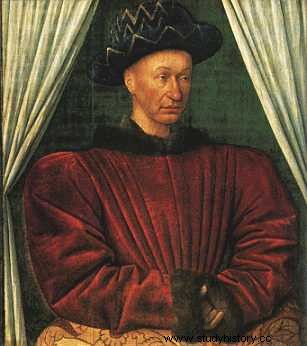
Portrait of Charles VII, by Jean FOUQUET (Louvre Museum, Paris)
The journey of Joan of Arc
Encounter with the dolphin in Chinon
Arriving in Chinon, Jeanne goes to the great hall of the castle. She had never seen the king before, and yet the anecdote tells that she recognizes him, hidden in his audience, while a subject had taken his place. Charles VII is astonished, the young girl presents herself under the name of Jeanne la Pucelle and that the king of heaven orders him to take her to Reims to have him crowned. Jeanne and Charles talk in secret, no one knows what they said to each other, but the king comes out with a bright face. Convinced, however, Charles had the prudence to have Joan examined by theologians in Poitiers. Jeanne's common sense is immediately sensational. "In what language do your Voices speak?" asked one of the brothers - Better than yours, she replied. -Do you believe in God? -Better than you. » Matrons even check her virginity. Charles gave him armour, a guard of a few men, and authorized him to join the last convoy destined to rescue Orléans. Jeanne had a standard made with the fleur-de-lis and the words JhesusMaria. Of all the other rough and sometimes cruel warlords, there is not one who dares to oppose the young girl, all have the heart to obey her. The men no longer swear, she dismisses the prostitutes who usually attach themselves to the convoy.
Sword of Joan of Arc
Once Jeanne's armor was made, we worried about the sword. “Go to Sainte-Catherine-de-Fierbois,” she said, to the pilgrimage chapel. You will dig behind the altar, you will remove a slab, some stones, and at a shallow depth you will find the sword I need. » So it was done, and a great sword was found with the hilt marked with five small crosses. Traditions affirm that this sword was that of Charles Martel who, after Poitiers, would have offered it to the priests of the sanctuary.
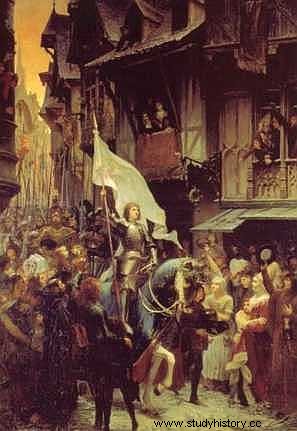
Entry of Joan of Arc into Orléans, by Jean-Jacques SCHERRER (1887)
The siege of Orléans
Before the arrival of Joan of Arc, Orléans is on the verge of surrender, the city has no more resources and is exhausted. Duke Charles of Orléans being taken prisoner after Agincourt, it was his half-brother Jean, dit Dunois, a bastard child, who courageously defended the city. While the French warlords hesitate and prevaricate, Jeanne returns secretly to the city to meet Dunois there. She summons him to make an outing, but the last one was too catastrophic for the bastard of Orleans to prefer to wait for reinforcements. Jeanne takes matters into her own hands, two English bastides stand in the region, they must be attacked! Jeanne charges the Augustinian bastide herself, the garrison follows her and it is a success. In the evening at the council of war, Dunois and his men want to leave it at that, but Jeanne refuses. She stirs up the population who prepares all night. The next day, the assault is given, the fortress is formidable, the losses are high, Jeanne is hit by a crossbow bolt above the breast. The wound is superficial, she returns to galvanize her troops. The English panic, they throw themselves into the Loire, May 8, 1429, Orleans is saved. It's a miracle ! For Jeanne, the capture of Orléans proves the divine character of her mission, the crowd even lends her healing powers. For the English, humiliated, the Maid is sent by the devil.
The Siege of Orleans
Liberator of the city, Jeanne earned the nickname "Maid of Orléans".
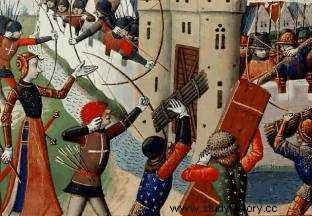
The Companions of Joan of Arc
Jeanne's journey is strewn with encounters with great warriors, faithful companions. In addition to the characters described below, there is of course Robert de Baudricourt, captain of Vaucouleurs. The gentlemen Jean de Metz and Bertrand de Poulengy who escorted Jeanne de Vaucouleurs to Chinon. The members of her military household:the page Louis Coutes and the squire Jean d'Aulon often described as the most faithful and devoted of the Maid's comrades in arms or even as her most "intimate" friend. Let us also mention Xaintrailles, Raoul de Gaucourt, Jean de Brosse and his lieutenant Admiral Louis de Culant. But the most famous are undoubtedly:
- The Duke of Alençon , the "nice duke" for Joan of Arc, commander in Patay, before intriguing against Charles VII, then Louis XI.
- Dunois , "Bastard of Orléans", son of Louis of Orléans. Responsible for defending Orléans, he became "the Restorer of the Fatherland" after his victory at Castillon.
- The brave La Hire , one of the best fighters of his time, later becoming the jack of hearts in card games.
- The demonic Gilles de Rais , accused of crimes such as "sodomy, witchcraft and murder". He inspired Bluebeard and Dracula.
- The Constable Richemont , one of Charles VII's greatest soldiers, he won the decisive victory at Formigny.
The coronation of the king
After the feat at Orléans, two possibilities were offered to the French:attack Paris or go to Reims, as Jeanne wanted, to crown the king. The Dauphin, hesitating, ends up agreeing with Jeanne. Only the bet is risky, Reims is surrounded by English and Burgundian possessions. A decisive meeting takes place in Patay, against the English of John Talbot, just driven out of Orleans. Everyone still has memories of Agincourt, a French cemetery. Only the Maid is there, and she assures the victory in the name of God. The battle begins, the French charge is irresistible, the English leave 2,000 dead and their leader prisoner. On the French side, the losses are almost nil. To open the road to Reims, the French liberated Auxerre, Troyes and Chalons. The Dauphin can finally enter the cathedral of Reims to receive the Holy Chrism. Jeanne is at his side, carrying his standard. The English regent, the Duke of Bedford, reacted without delay, he had young Henry VI crowned at Notre-Dame de Paris. But without the Holy Ampulla, which validates the ritual of the coronation, the coronation has no meaning. There is only one king left over France, the heir to the Valois, Charles VII. Jeanne's mission was crowned with success, in a few months the victory changed sides.
The coronation
Jeanne stands alongside the king during the ceremony. Later, during her trial, she was asked why she was holding her banner:"He had been in trouble, it was right that he was honored"
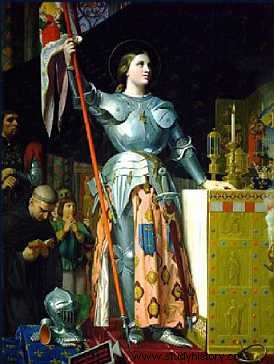
Joan of Arc - by INGRES (Louvre, Paris)
The capture of Joan of Arc
Without the Dauphin's hesitations, Jeanne would have accomplished her task a long time ago. Only, the young king is wasting time. And yet, wherever he goes, the crowd is galvanized, Laon, Coulommiers, Compiègne. In the cathedral of Beauvais deserted by its bishop, Pierre Cauchon, a Te Deum is celebrated in his honor. As Jeanne heads for Paris, the king prefers to negotiate with the Duke of Burgundy. Once under the walls of the capital, the French find that the English have had time to prepare. The assault is given at the Porte Saint Honoré. Wounded in the thigh, Jeanne nevertheless resumed the fight, but the miracle did not happen again. The king decides to lift the siege, and to dissolve the army. He does not want war but negotiation. Since the coronation, Charles VII treats the young Maid with disdain and jealousy. He decides to get rid of it by sending it to fight the companies, these brigands that du Guesclin had succeeded in driving out of the kingdom. But Jeanne lacks reinforcements and ammunition, the campaign is a failure. From 1430, the intentions of the Duke of Burgundy are clear, alongside the English, he wishes to take back the cities that have passed to the king. But Charles VII no longer has an army, he leaves Joan to fend for herself. She then surrounds herself with loyal knights, she recruits mercenaries… On Easter Day, she is acclaimed in Melun. She awaits the king's reinforcements, but they do not come. She then decides to defend Compiègne besieged, multiplying the exits against the enemy. That of May 24 is fatal, it goes too far, and is faced with a Burgundian counter-attack led by Jean de Luxembourg. The retreat takes place, it remains the last. When entering the city, the drawbridge is raised. Treason or recklessness? Either way, Jeanne is thrown off her horse and captured by the Burgundian lord.
Who is Joan of Arc?
Even if she wore short hair and had masculine clothes, Jeanne had feminine forms, and rather strong breasts, a face with a harmonious line. Charles d'Orléans detained in England would have offered her ceremonial clothes in the colors of the Orleans, thanks to this gift we know that Jeanne was 1m58 tall. Moreover, her virginity is proof of the authenticity of her mission. She claims her title of Maid herself. And yet Jeanne will share the bivouac with tough soldiers. Not one was inclined to carnal desire!
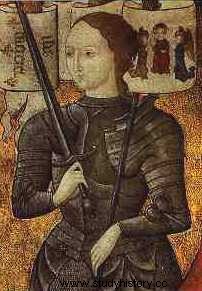
Joan of Arc, miniature from the Rouen Museum
The Trial of Joan of Arc
Lord Jean of Luxembourg has nothing to do with the Maid, he sells her to the English for ten thousand pounds. King Charles VII did nothing to save Joan, neither soldiers nor money. Henry VI places the young girl in the hands of ecclesiastical jurisdiction. Bishop Pierre Cauchon intends to judge her himself for heresy, claiming that she was captured in his diocese. Jeanne is therefore transferred to Rouen, firmly held by the English. It is locked in the keep of Bouvreuil castle which dominates the town. Cauchon carries out a new virginity test, but the Maid is indeed a virgin! In the preliminaries of the trial, he has nothing to accuse him of. Theologians take charge of the interrogation, but Jeanne shows incredible common sense, she manages to stand up to her judges. Cauchon then decides to practice interrogations behind closed doors. He asks her why she wears men's clothes, because it's more practical for travel and essential for combat, she replies. On the other hand, she refuses to wear women's clothes again, it should be remembered that she sleeps in chains in the middle of two roughnecks. But cross-dressing like this is a crime for the Inquisition, Cauchon finally has grounds for accusation. The real trial can begin, it is spread over two months. On May 23, in the cemetery of Saint Ouen, a public staging takes place. After an indictment of rare violence, Cauchon announces to Jeanne that she is condemned to the stake, the 19-year-old girl is terrified. He then gives her an act of abjuration which she signs with a cross:by committing to wear women's clothes, she escapes death. The English are furious, they want to eliminate him as soon as possible. But Pierre Cauchon knows that it will be done. In her cell, Jeanne is beaten, insulted and probably raped. Faced with this mistreatment, she decides to take up the man's habit. But Jeanne has regained her courage, she would rather go to the stake than end her life in irons.
Jeanne's common sense
“- Do you feel in the grace of God?
- If I'm not there, God put me there... If I'm there, God keep me there »
“- What did Saint Michael look like when he appeared to you? (…) Was he naked?
- Do you think that God does not have enough to dress him?
- Did he have hair?
- Why would they have been cut off? (…)
- Did he have a scale?
- I don't know (…) I am very happy when I see him…”
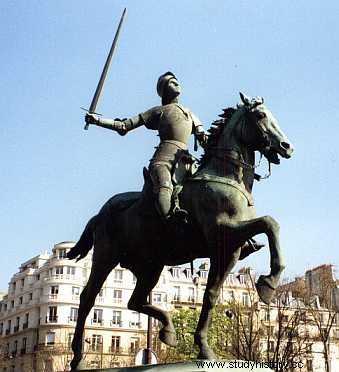
Statue of Joan of Arc, Place des Augustins
Joan the Saint
From heresy to canonization
Joan of Arc was declared a heretic and relapsed, she was condemned to the stake on May 30, 1431. On the square in Rouen, the crowd was pushed aside, Joan demanded a crucifix. Soon the flames reach him, "Jesus, Jesus, Jesus!" » she repeats. The crowd is moved, the soldiers are in tears:“We are all lost. We burned a saint! » The Church, which had condemned Joan of Arc, very soon took it to heart to rehabilitate her. In 1456, the condemnation of 1431 was declared void. But the girl has become a legend. Passed over in silence by the humanists of the 16th century, she became the patron saint of extremist Catholics during the wars of religion. The great French philosophers of the 18th century will not fail to ridicule her, this is the case of Voltaire and Beaumarchais, Diderot's Encyclopedia describes her as an "idiot manipulated by rogues" . But Catholic literature continues to praise the Maid. Jeanne had become a romantic heroine, the rise of modern patriotism made her increasingly popular. After the war of 1870, "the good Lorraine" embodies the hope of revenge of the French. In the 20th century, Joan was the object of a cult, she was beatified in 1909, then canonized in 1920 by Benedict XV.
Johannic legends
It happened during the story that imposters arise, claiming to be a deceased personality who marked his time. Several women came forward, claiming to have escaped the flames. Two of them managed to convince their contemporaries that they were really Joan of Arc:they are Jeanne des Armoises and Jeanne de Sermaises, who were perhaps one and the same person. Jeanne des Armoises appeared for the first time in 1436 in Metz where she met the two brothers of Joan of Arc, who recognized her as their sister. The city of Orléans suspended funeral services in memory of Joan of Arc for three years. This Jeanne, who is said to be the adulterine daughter of Isabeau of Bavaria and Louis of Orléans (brother of Charles VI), given as nurse to laborers from Domrémy, married a knight, Robert des Hermoises or des Armoises, near relative of Robert de Baudricourt. This Jeanne conversed with Charles VII by mail for four years. After gaining an audience with the king, she then publicly admitted her imposture. In 1457, when the Maid was rehabilitated, Jehanne de Sermaises appeared in Anjou. She was accused of having called herself the Maid of Orleans, of having worn men's clothes. She was imprisoned until February 1457, and released on the condition that she dress honestly. Other eccentric theses on the origin of Joan of Arc advance, for example, the masculinity of the Maid.
Joan of Arc at the stake
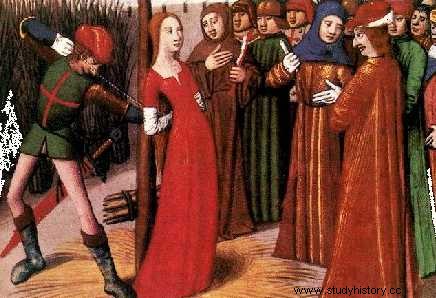
The end of a war
The end of the war
Having regained his legitimacy thanks to Joan of Arc, Charles VII was able to resume the offensive against the English. He signed the Treaty of Arras in 1435 with the Duke of Burgundy Philippe le Bon. In exchange for new lands, the duke renounces his alliance with the English. This is the end of the quarrel between Armagnacs and Burgundians. The conflict will resume later between Louis XI and Charles the Bold. The following year, in 1436, the Constable Richemont retook Paris, and Charles VII was able to make his triumphal return there. A truce with the English was signed in Tours in 1444. Charles VII, known as the Well Served, was surrounded by great advisers such as Jacques Coeur or his mistress Agnés Sorel. He can also rely on brave soldiers like Dunois or Richemont, but also the brothers Jean and Gaspard Bureau, engineers, who develop powerful artillery. The English, meanwhile, are mired in a dynastic conflict:“The War of the Roses”. In 1450, the Constable Richemont was victorious at Formigny, completing the reconquest of Normandy. At the same time, the royal host undertook the reconquest of Guyenne, Bordeaux was taken over by the French in 1450. The battle of Castillon, won by Dunois, completed the reconquest of the territory, only Calais remained in English hands (and this until in 1558). The Hundred Years War is over, Charles VII is the ultimate winner of this long conflict. There are now only three major vassal fiefdoms not attached to the crown:Brittany, Bourbon, and Burgundy. Note that England will keep the fleur-de-lis on its coat of arms until the 19th century.
Castillon's victory
With the capture of Bordeaux in 1450, Guyenne was almost reconquered by the French, but the demands of Charles VII made English guardianship regret. Henri VI charges John Talbot (already losing at Orléans and Patay) with the reconquest. After a rapid campaign, Bordeaux was recaptured. The French then decide to counter-attack. The Franco-Breton army comprises approximately 10,000 men including a powerful artillery of 300 pieces served by 700 maneuvers. The location chosen offers indisputable geographical advantages:To the north, a small river with steep banks; To the west, south and east, a 5m wide ditch. Warned of the arrival of the French, Talbot decided to help the Castillonnais. He is about to hear mass when he is told that the French are fleeing, abandoning the entrenched camp. We will know later that it was the pages and baggage useless in combat that left the battlefield. Deceived by these appearances, Talbot no longer hesitates and rushes with the troops at his disposal in order to rout the French. The French artillery, commanded by the Bureau brothers, had time to prepare. Scary carnage. The attackers are pressed against each other, they can neither escape nor hide. In the ensuing melee, Talbot is thrown to the ground and killed by some archer. At the sound of the cannonade, the Bretons in reserve at Horable charged with their cavalry and precipitated the rout of the English. Later, on July 18, the French advancing a few pieces of artillery under the walls of Castillon obtain the surrender of the city. In the same year in 1453, Constantinople fell to the Turks, the Middle Ages gradually came to an end.
